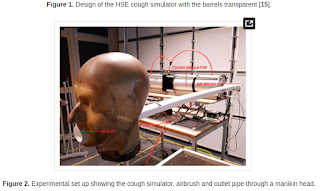
#17,126
Readers with long memories will recall that just about a decade ago, in Vomiting Larry And His Aerosolized Norovirus, we looked at an experiment conducted by the UK’s Health & Safety Laboratory on the aerosolization of norovirus during emesis.
In order to see how well (and how far) norovirus can spread through the air, scientists created a dummy that could projectile vomit. By adding a florescent dye marker to Larry’s `vomitus’, researcher determined that droplets – invisible to the naked eye – can end up as far as 3 meters away from the source.
In a similar vein, researchers at HSE have created a `coughing dummy', in order to study the effects of `covering' a cough with a hand, fist, or a (sleeved or sleeveless) crook of the elbow, as recommended by many public health agencies during COVID and influenza outbreaks.
It is probably not surprising that many of these recommendations are based more on what is `practical', than on solid scientific evidence of their efficacy.
As the backlit photo below illustrates, covering coughs deflects (up, down, or to the side) the `spray' of particles, but doesn't stop them. A sleeved elbow worked better than a bare elbow.
The obvious `downside' is that covering coughs with your hand leaves your hands contaminated, which can then contaminate fomites, like door knobs, desktops, and keyboards. Similarly, coughing into one's arms can still allow the transfer of the virus onto one's hands, with similar results.
Figure 10. (A) A cough into a cupped hand and then contact with a door handle; (B) a cough in to a bare inner elbow, hand contamination from arms being crossed so that hand touches contaminated inner elbow and then contact with a door handle.
Simulating the Environmental Spread of SARS-CoV-2 via Cough and the Effect of Personal Mitigations
by Claire Bailey *,Paul Johnson, Josh Moran, Iwona Rosa, Jodi Brookes, Samantha Hall and Brian Crook
Health and Safety Executive Science and Research Centre, Harpur Hill, Buxton, Derbyshire SK17 9JN, UK
Microorganisms 2022, 10(11), 2241; https://doi.org/10.3390/microorganisms10112241
Abstract
Background: A cough is known to transmit an aerosol cloud up to 2 m. During the COVID-19 pandemic of 2020 the United Kingdom’s National Health Service (NHS), other UK government agencies and the World Health Organization (WHO) advised people to cough into their elbows. It was thought that this would reduce viral spread and protect the public. However, there is limited peer reviewed evidence to support this.
Objectives: To determine if cough related interventions reduce environmental contamination, protecting members of the public from infection.
Methods: Scientists and engineers at the Health and Safety Executive (HSE) laboratory used a human cough simulator that provided a standardised cough challenge using a solution of simulated saliva and a SARS-CoV-2 surrogate virus; Phi6. Pseudomonas syringae settle plates were used to detect viable Phi6 virus following a simulated cough into a 4 × 4 m test chamber. The unimpeded pattern of contamination was compared to that when a hand or elbow was placed over the mouth during the cough. High speed back-lit video was also taken to visualise the aerosol dispersion.
Results and Discussion: Viable virus spread up to 2 m from the origin of the cough outwards in a cloud. Recommended interventions, such as putting a hand or elbow in front of the mouth changed the pattern of cough aerosol dispersion.
A hand deflected the cough to the side, protecting those in front from exposure, however it did not prevent environmental contamination. It also allowed for viral transfer from the hand to surfaces such as door handles. A balled fist in front of the mouth did not deflect the cough. Putting an elbow in front of the mouth deflected the aerosol cloud to above and below the elbow, but would not have protected any individuals standing in front. However, if the person coughed into a sleeved elbow more of the aerosol seemed to be absorbed. Coughing into a bare elbow still allowed for transfer to the environment if people touched the inside of their elbow soon after coughing.
Conclusions: Interventions can change the environmental contamination pattern resulting from a human cough but may not reduce it greatly.
(SNIP)
This study showed that if a person coughed into their hand it is possible for live viral particles to be subsequently transferred to areas in the environment such as door handles. The advice given by the NHS, WHO and other public health bodies throughout the world during the COVID-19 pandemic was for a person to cough into their inner elbow. The rationale was that this would reduce environmental contamination as the hand was not contaminated. However, this study showed that, at least in the short term after coughing into an inner elbow, there is a need not to touch that site as it was possible to transfer live viral particles if a person crossed their arms, for example, thereby touching the cough site with a hand. It is clear from this study and the work of others that the general public should be mindful of viral transfer.
Although the impacts of covering coughs is not as great as we'd like to think, it probably does reduce some of the airborne spread of viruses. Even though it isn't 100% effective, I much prefer wearing a face mask during times of high transmission.
While it may not be readily available to everyone - and it involves taking a pro-active step - I also carry a bottle of hand sanitizer with me, and use it frequently.


